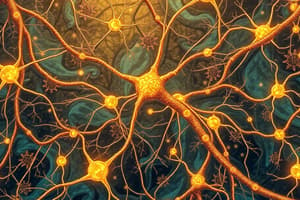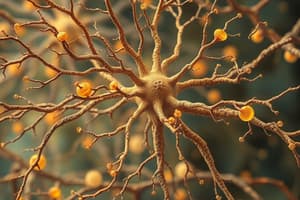Podcast
Questions and Answers
Which of the following mechanisms contributes to increasing the strength and speed of signal propagation along a neuron?
Which of the following mechanisms contributes to increasing the strength and speed of signal propagation along a neuron?
- Decreasing the diameter of the axon
- Reducing the number of neurotransmitter receptors on the dendrites
- The presence of myelin sheaths and Nodes of Ranvier (correct)
- Increasing the frequency of action potentials
Lipid-soluble hormones typically bind to receptors on the cell surface, triggering a cascade of intracellular events.
Lipid-soluble hormones typically bind to receptors on the cell surface, triggering a cascade of intracellular events.
False (B)
Describe the sequence of events that occurs from the moment a stimulus is received by a neuron's dendrites to the release of neurotransmitters at the synapse.
Describe the sequence of events that occurs from the moment a stimulus is received by a neuron's dendrites to the release of neurotransmitters at the synapse.
Stimulus reception -> Depolarization of dendrites -> Action potential initiation at axon hillock -> Propagation along axon -> Neurotransmitter release at synaptic terminal.
In a reflex arc, the signal bypasses the ______, allowing for a rapid response to a stimulus.
In a reflex arc, the signal bypasses the ______, allowing for a rapid response to a stimulus.
Match the following cell structures with their primary function:
Match the following cell structures with their primary function:
Flashcards
Myelin Sheath
Myelin Sheath
A fatty insulating layer around nerve axons, increasing speed of impulse transmission.
Nodes of Ranvier
Nodes of Ranvier
Gaps in the myelin sheath where action potentials are regenerated.
Photoreceptors
Photoreceptors
Specialized neurons that detect light.
Proprioception
Proprioception
Signup and view all the flashcards
Adrenal Glands
Adrenal Glands
Signup and view all the flashcards
Study Notes
- Neurons can be classified based on their shape or appearance.
- Nerve propagation involves the generation of action potentials.
- Signal strength in neurons can be increased.
- Neural signals travel from dendrites to the synapse.
Action Potential Process
- A stimulus is received by the neuron.
- The signal travels down the neuron.
- Specific events occur along the way.
Key Structures
- Myelin sheaths insulate axons.
- Nodes of Ranvier are gaps in the myelin sheath.
- Different types of neurons transmit signals in and out of the central nervous system.
Anatomy
- Eye
- Brain
Senses
- Photoreceptors detect light.
- Proprioception is the sense of body position and movement.
Hormones
- Hormones travel through the bloodstream.
- Hormones affect blood cells.
- Adrenal glands produce hormones.
Cell Functions
- Dendrites receive signals.
- Axons transmit signals.
- The synaptic cleft is the gap between neurons.
- Vesicles store neurotransmitters.
- Neurotransmitters transmit signals across the synaptic cleft.
- Neurons release neurotransmitters.
Reflexes
- Reflex actions bypass the brain for quick responses.
Receptors
- Pain receptors detect pain.
Solubility
- Lipid-soluble hormones interact differently with cells compared to water-soluble hormones.
Signal Transduction Pathway
- Understand how to label cells in a signal transduction pathway.
Calcium
- Calcium is crucial in the body.
- Calcium homeostasis is the process of maintaining stable calcium levels.
- Know all hormones.
- Calcium has various uses in the body.
Studying That Suits You
Use AI to generate personalized quizzes and flashcards to suit your learning preferences.




